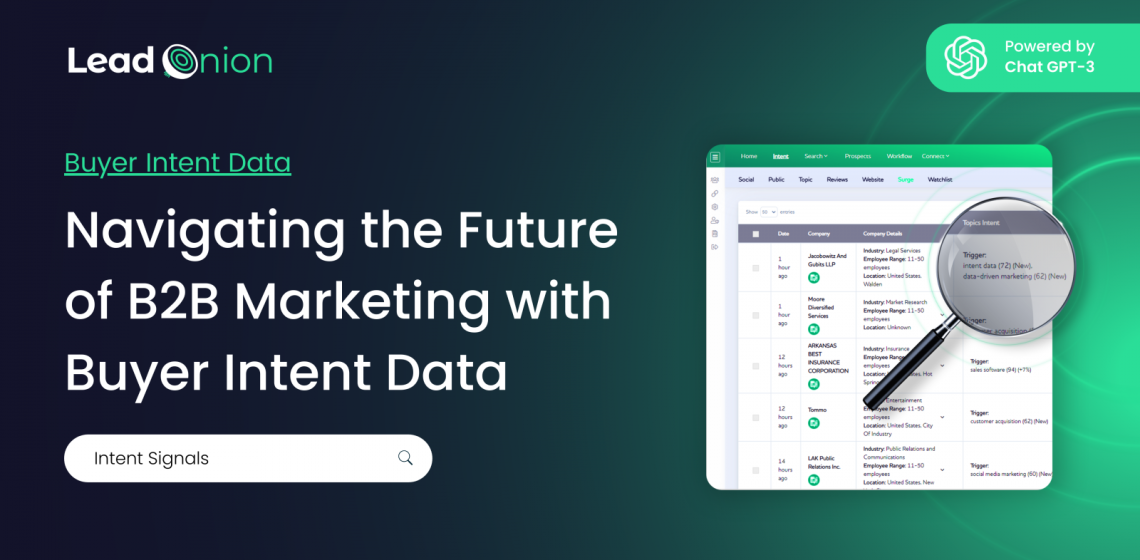Where consumer expectations for personalized products and services are continually on the rise, B2B marketers find themselves facing a formidable challenge. The need to create marketing campaigns precisely attuned to the unique preferences of potential buyers has never been more crucial. In this fast-paced realm of today's digital economy, marked by speed, innovation, and personalization, marketers relying on antiquated methods of data collection struggle to stay ahead.
Amid this challenging landscape, a solution emerges—buyer intent data. This pivotal tool not only navigates the complexities of modern marketing but also serves as the compass guiding marketers toward success in meeting the ever-changing demands of the contemporary consumer landscape.
1. Understanding Buyer Intent Data:
Intent data, derived from individuals' online activities, serves as a cornerstone in digital strategies. It provides a nuanced understanding of a user's interest in acquiring products, making it a crucial component in the success of B2B digital marketing. However, a significant gap exists in fully leveraging intent data.

Marketers can harness various intent signals to identify buyer intent, with content consumption, research frequency and volume, account context, and purchasing indicators being some of the most common. These signals offer valuable insights into the buyer's journey, enabling marketers to tailor their strategies to meet the evolving needs of potential clients.
2. The Perks of Implementing Intent Data:
Intent data stands as a linchpin in the realm of account-based marketing (ABM), furnishing B2B marketers with the precision needed to zero in on target accounts and cultivate a harvest of highly qualified leads for their sales teams. Delving into the realm of intent data unfolds a trove of benefits:
a. Identify markets you didn’t know existed:
In a world where traditional marketing often relies on outdated information or mere intuition, intent data emerges as a beacon of accuracy. It provides a profound understanding of your target accounts, revealing prospective buyers that might have eluded detection through conventional methods.
b. Target individuals at the start of the buyer journey:
Timing is everything, especially when it comes to reaching potential buyers. Analyzing intent signals empowers you to identify target accounts early in the buyer journey, positioning your outreach right at the inception of their market exploration. This strategic advantage over competitors translates into tangible value for your sales teams.
c. Fine-tune your marketing campaigns:
Intent data isn't just about identifying audiences; it's about understanding the nuances of the content potential customers are consuming. This insight is pivotal, allowing you to craft new assets that directly address their queries and provide tailored solutions. Embedding this content into well-timed email campaigns ensures you deliver value precisely when it's needed.
d. Save time, money, and resources:
The amalgamation of these benefits transforms your marketing campaigns, enhancing your lead generation strategies and streamlining the path to more efficient business growth for your sales teams. This optimization not only saves time and resources but also allocates valuable resources to other facets of your business or additional marketing initiatives.
3. Exploring the Tapestry of Intent Data Types:
In the intricate world of intent data, distinctions arise based on the organizations that initiate the data collection process. Let's unravel the three main categories of intent data, each with its unique characteristics:
a. First-party intent data:

Picture a realm where insights are drawn directly from your digital abode—your website, email campaigns, and social media posts. While first-party data stands out as the most cost-effective option, it has its limitations. You're confined to the accounts that directly engage with your online assets, leaving a void in information about potential customers yet to discover your business.
b. Second-party intent data:

Enter organizations like content syndication providers, wielding extensive libraries of content assets. They decode consumption patterns within their accounts and may offer this data to marketers at other companies. This enriches your first-party data with a broader spectrum of intent data sources, expanding your insights beyond the confines of your immediate digital sphere.
c. Third-party intent data:
Imagine a landscape where data is harvested from third-party websites and then curated for B2B marketers. Third-party data emerges as a powerful and comprehensive avenue for gathering insights about potential buyers. In fact, Gartner reveals that around 50% of research time is spent by prospective buyers on third-party sources. Accessing this data widens the marketing net, providing a panoramic view of prospects, users, and accounts across diverse online platforms.
As marketers navigate this nuanced landscape, the choice among these intent data types hinges on careful consideration. Factors such as budget constraints, the nature of the potential customer base, and the capacity for in-house data collection play pivotal roles in determining the most fitting approach for B2B marketing needs.
4. Navigating the Landscape of B2B Intent Data:
a. First-Party Intent:
Acquiring first-party data stands as a relatively straightforward endeavor, often accomplished by deploying analytics tools like Google Analytics. Through these tools, marketers gain valuable insights into online user behavior, unraveling details such as time spent on the site, visited pages, consumed content, and the duration of engagement on each page.
However, being aware of behavior is great, but it isn’t much use unless you know who is carrying out those engagements.
Lead Onion takes the journey further by transforming anonymous website visitors into actionable company and contact-level data. While traditional first-party data sources provide a broad understanding of user behavior, Lead Onion refines this process, allowing marketers to peel back the layers of anonymity and target accounts already expressing interest in the brand and providing key target person contact information from that brand.
By leveraging advanced analytics and proprietary algorithms, Lead Onion not only decodes user interactions but also unveils the specific accounts behind those actions. This transformative approach empowers marketers to go beyond the surface, ensuring that every engagement is not just informative but a strategic step towards forging meaningful connections with potential leads.
b. Second-Party Intent:
Embarking on the realm of Second-Party Intent Data introduces a compelling twist to the narrative of data acquisition.
Picture this: it's not just about collecting information; it's about diving into a rich pool of insights curated by another company, e.g. via review sites like G2 and ContentGine.
G2 diligently gathers and dissects data from visitors exploring industry categories or customer profiles, offering this invaluable information back to the listed companies. While the allure of this data is undeniable, the challenge lies in operationalizing it effectively.
For G2 customers, the dual hurdles of dealing with company-level data and the necessity to supplement it with contact-level information for key decision-makers emerge. This is where Lead Onion steps into the spotlight, bridging the operational gap with finesse.
The seamless fusion of CONTENTgine and Lead Onion gives you access to contact-level intent data from those actively downloading industry-specific content, yes contact level!
Their colossal content database is brimming with hundreds of thousands of assets encompassing white papers, case studies, and more.
Collaborating with CONTENTgine isn't just about gathering data; it's about tapping into the most in-depth intent data available. This trove of insights becomes the secret sauce for crafting compelling Account-Based Marketing (ABM) campaigns that not only resonate but drive superior lead generation for sales teams. It's a symbiotic partnership that propels businesses into the forefront of targeted marketing excellence.
Now, the synergy of G2's and ContentGine’s data and Lead Onion's second-party intent function opens up new dimensions, allowing businesses to amplify their understanding by cross-referencing data from diverse sources.
c. Third-Party Intent:
Embarking on the realm of Third-Party Intent Data unveils a rich tapestry of insights into digital behaviors beyond your owned insights.
.png)
Picture this: A symphony of keyword and topic mentions, and the buzz of competitor discussions echoing across external sources like Blogs, B2B publishers, Forums, and dynamic online communities. This rich tapestry extends to the public data realm of social media networks, including the likes of LinkedIn.
According to Gartner's research, more than 70% of B2B marketers are harnessing third-party data.
However, the challenge arises when most B2B intent data providers rely on specific data collection methods, inevitably limiting their reach and the consequential impact of intent data for their customers.
5. In Conclusion:
Lead Onion stands alone in the provider market as the unparalleled force in Buyer Intent data. Our platform uniquely integrates insights from 18 sources of intent, combining first, second, and third-party data seamlessly.
Beyond traditional limitations, Lead Onion transforms user behavior insights by unveiling the specific accounts behind interactions, allowing marketers to target those already expressing interest in their brand.
With its capacity to tap into 18 diverse sources of intent, Lead Onion emerges as the industry's unique and transformative solution, driving unparalleled success in the pursuit of targeted marketing goals.



